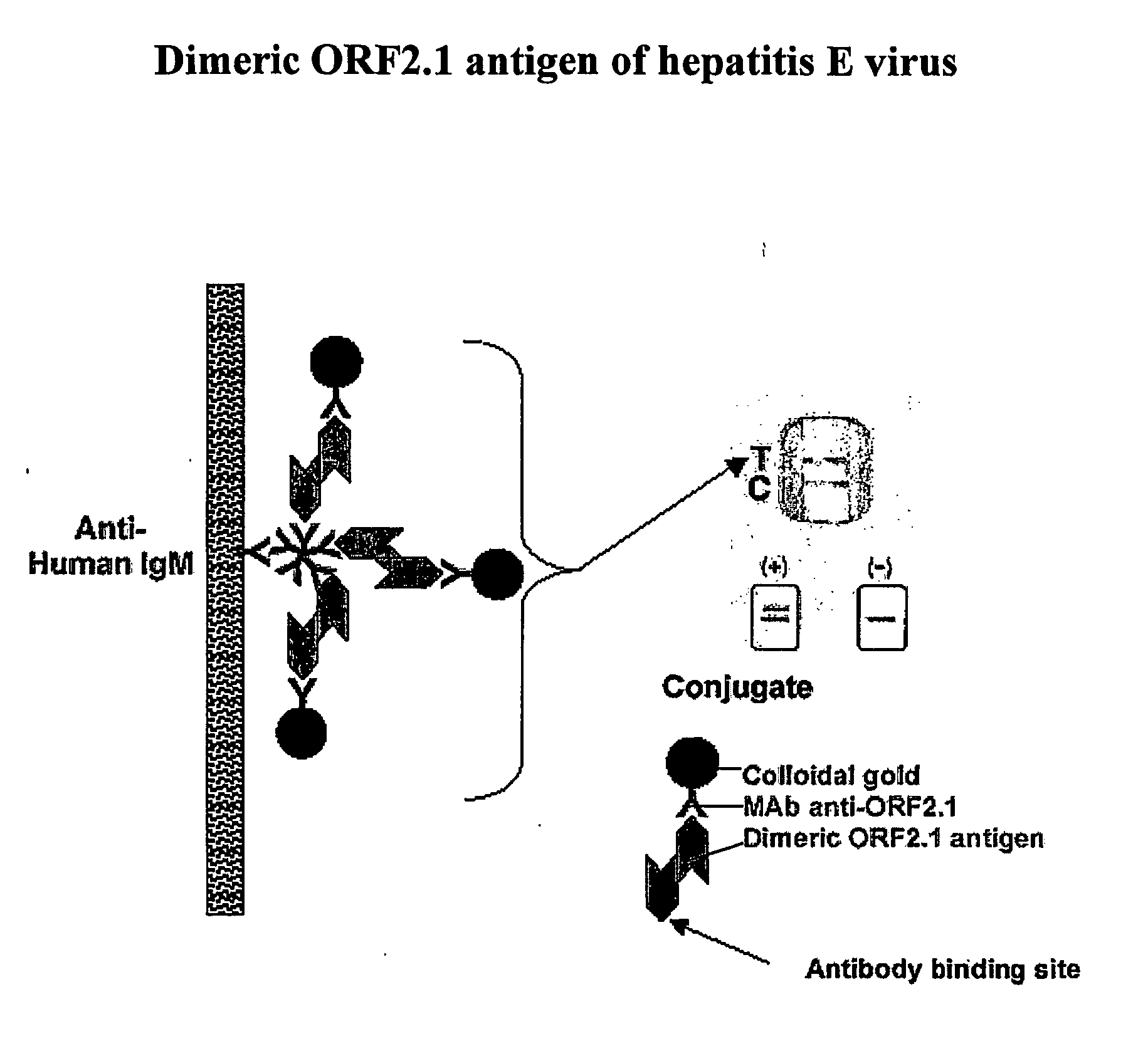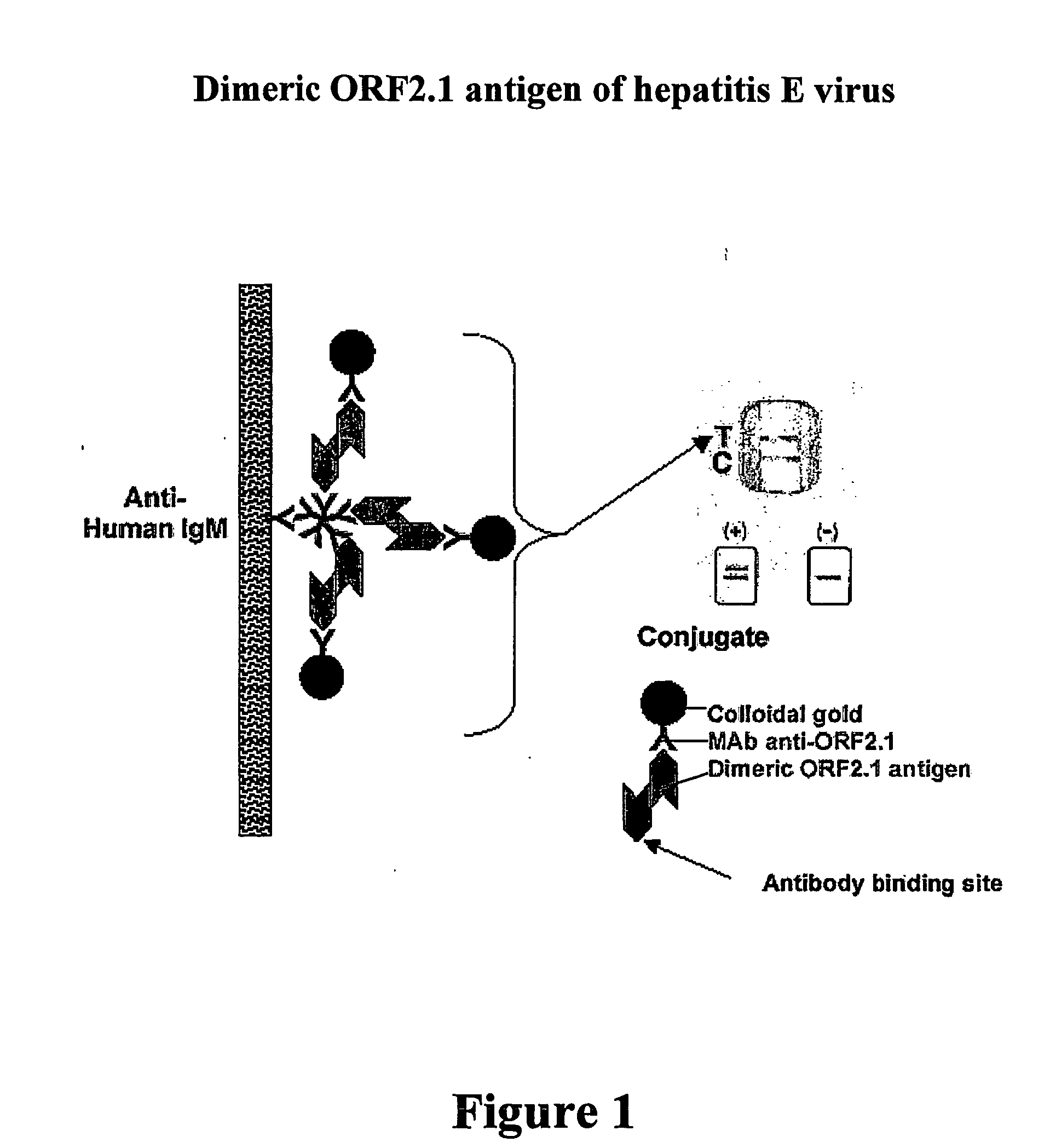Binding Assay Components
a technology of binding assay and components, applied in the field of diagnostics, can solve the problems of unreliability of tests, non-specific reactions, and reduced immune reactivity between antigens, and achieve the effect of maximising the availability of binding sites and maximising the availability of epitopes
- Summary
- Abstract
- Description
- Claims
- Application Information
AI Technical Summary
Benefits of technology
Problems solved by technology
Method used
Image
Examples
example 1
Dimeric ORF2.1 Antigen of Hepatitis E Virus
[0088] In this example the colloidal gold-antibody conjugate is complexed with dimeric hepatitis E virus ORF2.1 antigen before the conjugate is applied to the device during manufacture. The monoclonal antibody (McAb 4B2) may be directed against the immunodominant epitope in the antigen of interest, and in the presence of saturating amounts of antigen only one molecule within the dimer will react with monoclonal antibody bound to the colloidal gold, leaving the second molecule within the dimer to react with patient antibody to give a visible signal in a diagnostic test as represented schematically in FIG. 1. In the examples, the patient antibody is IgM to indicate current or recent infection with the disease organism encoding the antigen of interest, but it is evident that the methods could be equally used for other classes of antibody (such as IgG or IgA or IgE) by substitution of the appropriate anti-immunoglobulin antibody on the solid p...
example 2
Multimeric Antigen of Hepatitis A Virus
[0089] The colloidal gold-antibody conjugate is complexed with hepatitis A virus particles (antigen) during performance of the assay, by bringing together the separate assay compartments containing the two parts. In this example, the monoclonal antibody (K34C8) may also be directed against the immunodominant epitope in the antigen of interest (virus), but under defined conditions such as virus concentration and time of incubation only one or a few copies of the epitope within each virus particle will react with monoclonal antibody bound to the colloidal gold, leaving the remaining epitopes within the virus particle to react with patient antibody to give a visible signal in a diagnostic test as shown schematically in FIG. 2.
example 3
Virus-Like Particle (VLP) of Duck Hepatitis Virus
A. Use of Anti-DHBV Bridge
[0090] In this example, the colloidal gold-antibody conjugate may be preferentially complexed with virus-like particles (VLPs) of duck hepatitis B virus (DHBV) in which the antigen of interest is expressed as part of the chimeric VLP (described in International Publication No. WO 2004 / 092387 in the name of Hepgenics Pty Ltd). In this example, the monoclonal antibody which is conjugated to colloidal gold (7C12) is directed against an epitope in the DHBV part of the VLP (the S or L antigen) rather than in the antigen of interest, thereby leaving copies of the antigen of interest within the VLP to react with patient antibody to give a visible signal in a diagnostic test as shown schematically in FIG. 3.
PUM
 Login to View More
Login to View More Abstract
Description
Claims
Application Information
 Login to View More
Login to View More - R&D
- Intellectual Property
- Life Sciences
- Materials
- Tech Scout
- Unparalleled Data Quality
- Higher Quality Content
- 60% Fewer Hallucinations
Browse by: Latest US Patents, China's latest patents, Technical Efficacy Thesaurus, Application Domain, Technology Topic, Popular Technical Reports.
© 2025 PatSnap. All rights reserved.Legal|Privacy policy|Modern Slavery Act Transparency Statement|Sitemap|About US| Contact US: help@patsnap.com



